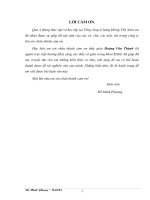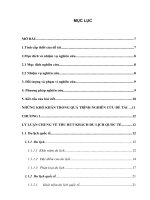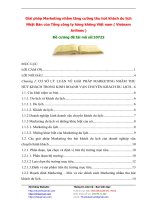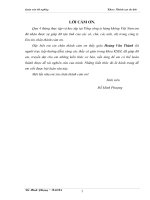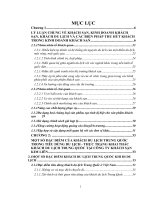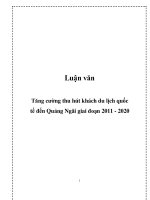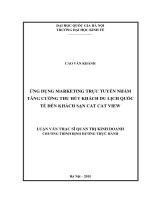TĂNG CƯỜNG THU hút KHÁCH DU LỊCH đến CÔNG VIÊN địa CHẤT TOÀN cầu CAO NGUYÊN đá ĐỒNG văn TỈNH hà GIANG e
Bạn đang xem bản rút gọn của tài liệu. Xem và tải ngay bản đầy đủ của tài liệu tại đây (1.11 MB, 100 trang )
INTERNATIONAL EXECUTIVE
MASTER OF BUSINESS ADMINISTRATION
THESIS
STRENGTHENING THE ATTRACTION OF TOURISTS
TO DONG VAN KRAST PLATEAU GLOBAL GEOPARK
IN HA GIANG
CONFIRMATION
The Unit: Project Management Unit of Dong Van Karst Plateau Geopark, Ha Giang
Province (Dong Van Karst Plateau Geopark PMU).
Confirms that: Mr. Do Viet Hop, working for People's Committee of Yen Minh
District, Ha Giang Province, as a student of class ieMBA B03 of PGSM International
business administration master training program has selected Dong Van Karst Plateau
Geopark PMU for his research and thesis preparation with topic "Strengthening the
attraction of tourists to Dong Van Krast Plateau Global Geopark in Ha Giang".
Project Management Unit of Dong Van Karst Plateau Geopark, Ha Giang Province
confirms that all data used in the thesis of Mr. Do Viet Hop is absolutely true and accurate.
Leaders of Project Management Unit of Dong Van Karst Plateau Geopark, Ha Giang
Province highly appreciates the practical value of the research, especially the proposed
solutions for Project Management Unit of Dong Van Karst Plateau Geopark, Ha Giang
Province to apply in the future to enhance the attraction of tourists to Dong Van Karst
Plateau Geopark to contribute to strong and sustainable development of the tourism in Ha
Giang province in general, Dong Van Karst Plateau Geopark in particular.
Project Management Unit of Dong Van Karst Plateau Geopark
MANAGER
AFFIDAVIT
i
On basis of research and collection of data, information, thank to the assistance of Dong
Van Krast Plateau Global Geopark Management Unit of Ha Giang province, Department of
Culture, Sports and Tourism, attention and enthusiastic instructions of the Guiding Teacher
Assoc. Prof. Dr. Ngo Thi Tuyet Mai – Dean of International Economics, Institute of
Commerce and the International Economics, Hanoi University of National Economics as
well as self-efforts, the author completes the Master’s Thesis in International Business
Administration with the topic of “Strengthening the attraction of tourists to Dong Van
Krast Plateau Global Geopark in Ha Giang”.
The author hereby warrants that the document is researched, collected, and
analyzed on basis of information and data from varied sources to complete the
Graduation Thesis which is not copied illegally from any other documents.
Ha Giang, 8 th October 2013
Undertaken by
Do Viet Hop
ii
TABLE OF CONTENTS
CONFIRMATION...................................................................................................................................................................I
AFFIDAVIT..............................................................................................................................................................................I
TABLE OF CONTENTS.....................................................................................................................................................III
LIST OF ABBREVIATIONS............................................................................................................................................VII
LIST OF TABLES AND FIGURES................................................................................................................................VIII
LIST OF MAPS AND CHARTS.........................................................................................................................................IX
INTRODUCTION...................................................................................................................................................................1
LIST OF REFERENCE DOCUMENTS............................................................................................................................X
iii
CONTENTS
CHAPTER 1.............................................................................................................................................................................4
BASIC THEORY ON TOURISM AND ATTRACTION OF TOURISTS.....................................................................4
1.1. OVERVIEW ON TOURISM AND TOURISTS.
4
1.1.1. Concepts on tourism and tourists.........................................................................4
1.1.2. Types and promotion of tourism..........................................................................6
1.1.3. Features and importance of the attraction of tourists...........................................8
1.2. ATTRACTION OF TOURISTS
9
1.2.1. Propaganda and popularization of tourism..........................................................9
1.2.2. Tour joint...........................................................................................................10
1.2.3. Connection in tourism promotion......................................................................10
1.2.4. Training and cultivation of human resources for tourism..................................11
1.2.5. Investment in technical facilities for tourism......................................................12
1.3. EFFECTS ON THE ATTRACTION OF TOURISTS
13
1.3.1. External factors (PEST model)..........................................................................13
1.3.2. Internal factors...................................................................................................17
1.4. EXPERIENCE ON TOURISM PROMOTION OF SOME PROVINCES AND LESSONS
LEARNT FOR HA GIANG
21
1.4.1. Experience on tourism promotion of some provinces and cities........................21
1.4.1.1. Experience on tourism promotion of Hanoi....................................................21
1.4.2. Lessons learned.................................................................................................25
CHAPTER 2...........................................................................................................................................................................29
REALITY ON THE ATTRACTION OF TOURISTS TO DONG VAN KARST PLATEAU GLOBAL
GEOPARK IN HA GIANG.................................................................................................................................................29
2.1. INTRODUCTION TO DONG VAN KARST PLATEAU GLOBAL GEOPARK IN HA
GIANG
29
2.1.1. Background.......................................................................................................29
..................................................................................................................................... 31
2.1.2. Management Board of Global Geopark.............................................................32
2.1.3. Investment expenditure of the Global Geopark.................................................36
2.1.4. Some investment projects in Global Geopark....................................................38
2.2. ANALYSIS ON THE POTENTIALITY AND IMPACTS ON THE ATTRACTION OF
TOURISTS TO DONG VAN KARST PLATEAU GLOBAL GEOPARK
39
iv
2.2.1. Tourism potentiality...........................................................................................39
2.2.2. Evaluation of factors impacting tourist attraction..............................................43
2.3. TOURIST ATTRACTION ACTIVITIES TO THE DONG VAN ROCK HIGHLANDGLOBAL GEOPARK IN THE RECENT TIME
49
2.3.1. Propaganda and tourism promotion...................................................................49
2.3.2. Connection of Tours..........................................................................................52
..................................................................................................................................... 54
2.3.3. Connection in tourism promotion......................................................................54
2.3.4. Training and fostering the tourism human resource...........................................58
..................................................................................................................................... 60
2.3.5. Investment in technical infrastructure to support the tourism............................61
2.4. REALITY OF TOURIST ATTRACTION TO DONG VAN ROCK HIGH LAND GEOPARK
62
2.4.1. Turns / number of tourists to the Geopark.........................................................62
2.4.2. Structure of Tourists in the Tourism Market......................................................63
2.4.3. Revenue from tourism of the Geopark..............................................................63
2.5. GENERAL EVALUATIONS ON TOURIST ATTRACTION TO DONG VAN KARST
PLATEAU GLOBAL GEOPARK
65
2.5.1. Achievements....................................................................................................65
2.5.2. Limitations and reasons.....................................................................................66
CHAPTER 3...........................................................................................................................................................................70
ORIENTATION AND SOLUTIONS TO INTENSIFYING TOURIST ATTRACTION TO DONG VAN
KARAST PLATEAU GLOBAL GEOPARK IN HA GIANG PROVINCE................................................................70
3.1. FORECAST AND ORIENTATION OF TOURIST ATTRACTION TO HA GIANG
PROVINCE, PERIOD OF 2013 – 2020
70
3.1.1. Forecast of tourists to Ha Giang Province.........................................................70
3.1.2. Orientation of tourist attraction to Dong Van Karst Plateau Global Geopark....72
3.2. SOLUTIONS TO INTENSIFYING TOURIST ATTRACTION TO DONG VAN KARST
PLATEAU GLOBAL GEOPARK
75
3.2.1. Effective implementation of mechanisms, policies to secure prioritized finance
resourced invested to the tourism promotion of the Geopark.......................................75
3.2.2. Improvement of tourism promotion capacity of the Geopark............................76
3.2.3. Intensifying connection in tourism promotion of the Geopark..........................76
v
3.2.4. Intensifying international cooperation in tour connection.................................77
3.2.5. Diversifying tourism products and construction of tourism value sequence of the
Geopark........................................................................................................................ 78
3.2.6. Strengthening tourism propaganda activities of the Geopark............................79
3.2.7. Strengthening tourism advertisement activities of the Geopark.........................81
3.2.8. Consolidation of the tourism promotion apparatus in the Geopark...................81
3.2.9. Tăng cường đầu tư cơ sở vật chất cho du lịch vùng Công viên.........................82
3.3. RECOMMENDATIONS ON PROMOTION OF TOURIST ATTRACTION TO DONG VAN
KARST PLATEAU GLOBAL GEOPARK IN HA GIANG
82
3.3.1. Recommendations to the State and UNESCO...................................................82
3.3.2. Recommendations for Ha Giang province and 4 districts in the Geopark.........83
3.3.3. Recommendations for travel agencies in the area..............................................85
CONCLUSIONS...................................................................................................................................................................86
vi
LIST OF ABBREVIATIONS
Abbreviations
English full name
ASEAN
Association of South East Asian
BQL
The Management unit
CVĐCTC
Global Geopark
FAM Trip
GDP
Familiarization Trip
Gross Domestic Product
GGN
Global Geopark Network
JATA
Japan Association of Travel Agents
KHĐC&KS
Geologic & Mineral Science
PATA
TPHCM
Pacific Asia Travel Association
Ho Chi Minh City
UBND
The People’s Committee
UNESCO
United Nations Educational, Scientific, and Cultural
Organization
UBQG
The National Committee
UNWTO
United Nations World Tourism Organization
USTOA
VHTT&DL
United States Tour Operators Association
Culture, Sports and Tourism
WTO
World Trade Organization
vii
LIST OF TABLES AND FIGURES
TABLE 2.1: INVESTMENT FUNDS FOR TOURISM OF DONG VAN KARST PLATEAU GLOBAL
GEOPARK WITHIN 2009 – 2012......................................................................................................................................37
TABLE 2.2: ECONOMIC GROWTH OF HA GIANG AND DONG VAN ROCK HIGHLAND- THE FIRST
INTERNATIONAL GEOPARK OF VIETNAM AND GEOHERITAGE PRESERVATION..................................45
TABLE 2.3: SOME SOCIO-CULTURAL TARGETS OF DONG VAN ROCK HIGHLAND- THE FIRST
INTERNATIONAL GEOPARK OF VIETNAM AND GEOHERITAGE PRESERVATION..................................46
TABLE 2.4: SOME EVENTS AND TRADE FAIR IN HA GIANG AND DONG VAN ROCK HIGH LAND
GLOBAL GEOPARK IN 2010 – 2012...............................................................................................................................50
TABLE 2.5: PUBLICATIONS, PRODUCTS OF THE TOURISM ISSUED BY HA GIANG AND THE
GEOPARK IN 2009 – 2012..................................................................................................................................................52
TABLE 2.6: STATISTICS OF TOURISM EVENTS WITH PARTICIPATION OF DONG VAN ROCK HIGH
LAND GEOPARK IN PERIOD OF 2010 – 2012.............................................................................................................53
TABLE 2.7: SOME CONNECTION ACTIVITIES OF THE GEOPARK MANAGEMENT UNIT TO
ATTRACT THE TOURISTS..............................................................................................................................................54
TABLE 2.8: NUMBER OF TOURISTS TO HA GIANG AND THE GEOPARK......................................................62
TABLE 2.9: REVENUE FROM THE TOURISM AND EXPENDITURE OF TOURISM PROMOTION OF
THE GEOPARK IN PERIOD OF 2009 - 2012.................................................................................................................64
TABLE 3.1: PLAN TO ATTRACT TOURISTS TO THE GEOPARK IN THE PERIOD 2013-2015....................75
viii
LIST OF MAPS AND CHARTS
FIGURE 2.1: ORGANIZATIONAL CHART OF THE MANAGEMENT BOARD OF DONG VAN KARST
PLATEAU GLOBAL GEOPARK......................................................................................................................................33
FIGURE 2.2: NUMBER OF TOURISTS TO HA GIANG AND THE GEOPARK...................................................63
FIGURE 2.3: REVENUE FROM TOURISM AND TOURISM PROMOTION EXPENDITURE........................65
FIGURE 3.1: INTERNATIONAL TOURISTS TO REGIONS AND TERRITORIES FROM 1950 AND
FORCAST BY 2020..............................................................................................................................................................71
ix
INTRODUCTION
1. Essentiality of the topic
In the recent year, in the implementation of comprehensive innovation policy of the
Party and the Government, with the trend of international economic integration, the
Vietnam tourism has experienced strongly development steps and increasingly hade active
impacts on many aspects of the life and socio-economy. Tourism nowadays becomes the
core section of the national economy and gradually further integrates with the area and the
world. More and more tourists come to Vietnam in general and Ha Giang in particular
increase.
According to declaration in the G20 Leaders Summit on tourism held on 16/5/2012 in
Mexico, income from the tourism makes up 9% of GDP worldwide. In 2011, in the context
of the global economic crisis, the tourism in the world reaches 982 million tourists and
income from tourism increases 3.8%. This is satisfactory sign and estimated to
continuously increase in the coming years and achieves 18 billion tourists in 2030. In
addition to, the tourism significantly contributes to the creation of jobs, labors for the
tourism account for 8% of the global labors, every job in this is expected to create two jobs
for others.
The Tourism has had prompt and constant growth, according to declared date of
Vietnam National Administration of Tourism, the international tourists to Vietnam reach
5,049,855 visits in 2010 and 6,014,032 visits in 2011 increasing 6,847,678 visits in 2012.
Furthermore, domestic tourists have rapidly increased from 28 million visitors in 2010 to
30 million visitors in 2011, achieving 32.5 million visitors in 2012. Total revenue of the
tourism accordingly increases from VND 96,000 billion in 2010 to VND 160,000 billion in
2012. The development of tourism thus not only meets the senior demands of every
individual but also contributes to the development of economy of each country and locality.
Dong Van Karst Plateau Global Geopark of Ha Giang province located in the north of
the country consists of four rocky mountainous and upland districts (Quang Ba, Yen Minh,
Dong Van and Meo Vac) with plenty of natural resources, historical and cultural values
assessed as potentiality for exploitation and development of tourism and currently becomes
a attractive and friendly destination of visitors.
Determining the important location of the Tourism to the socio-economic
development and with the purpose of effectively exploiting plentiful tourism potentialities,
Ha Giang province considers the tourism development as one of strengths in the socioeconomic development strategies of the Dong Van Karst Plateau. On the basis of master
1
plan on preservation, embellishment and promotion of value of Dong Van Karst Plateau
Global Geopark of Ha Giang province approved by the Prime Minister in Decision no.
310/QĐ-TTg dated 07/02/2013 and in the near future, this Geopark will be an attractive
destination of the regional and global tourists.
However, the tourism development of Dong Van Karst Plateau Global Geopark at
present is not corresponding to the potentiality. Ha Giang should complete strategies on
tourism image promotion of the Park, increasing solutions to attract the tourists to the Park
in the future so that tourism becomes the core economy of four Northern rocky
mountainous and upland districts of the country.
From above stated matters, I decide to choose the topic on “Strengthening the
attraction of tourists to Dong Van Krast Plateau Global Geopark in Ha Giang” as my
Master thesis.
2. Purpose
- Systematizing the basic theories on tourism and attraction of tourists.
- Analyzing potentialities and factors affecting the attraction of tourist to Dong Van
Karst Plateau Global Geopark, Ha Giang.
- Analyzing and evaluating the reality of tourism activities of Dong Van Karst Plateau
Global Geopark in Ha Giang in the recent years, stating strengths and weaknesses in the
tourism development of the Geopark.
- Proposing orientations and solutions to the Management Board of Dong Van Karst
Plateau Global Geopark, Ha Giang to strengthen the attraction of tourists to the geopark in
the near future.
3. Objects and scope of research
- Objects: Domestic and international tourists to Dong Van Karst Plateau Global
Geopark in Ha Giang.
- Scope of research: Dong Van Karst Plateau Global Geopark area includes
administrative boundaries of four Northern rocky mountainous districts of Ha Giang
province including Quang Ba, Yen Minh, Dong Van and Meo Vac with area of more than
2,350km2. Research duration of 5 recent years (2008 – 2012) and orientation to 2020;
especially since 2010 when Dong Van Rock Highland was recognized as a global geopark..
4. Method of study
Methods on description, information collection, summary and analysis are used to this
topic.
In the terms of method on information collection, the topic mainly applies such
secondary information as syllabus, books, magazines, reports of the geopark management
2
board, Culture and Information Department, reports of district People’s Committee within
the Geopark area, etc.
Information analysis concludes processing, summary, calculation, comparison,
assessment and conclusion. Information sources are summarized, analyzed, selected;
statistic data is handled under analysis and statistics principle.
Conclusion is based on proper analysis and assessment of data collected.
4. Structure and outline of the thesis
a- Chapter 1: Basic theory on tourism and attraction of tourists.
b- Chapter 2: Reality on the attraction of tourists to Dong Van Karst Plateau Global
Geopark in Ha Giang.
c- Chapter 3: Orientation and solutions for strengthening the attraction of tourist to
Dong Van Karst Plateau Global Geopark in Ha Giang.
3
Chapter 1
BASIC THEORY ON TOURISM AND ATTRACTION OF TOURISTS
1.1. Overview on tourism and tourists.
1.1.1. Concepts on tourism and tourists
1.1.1.1. Tourism.
Since the old days, tourism is regarded as a hobby, active relaxation of the
people. Tourism today becomes an essential demand in the social life.
In the terms of economy, tourism is one of effective trades, the additional source of
significantly foreign currencies for the economic development of every country and
deemed as a “smokeless industry.”
Concept of tourism, along with the tourist development, is also understood in various
ways depending on study points of view.
Under the opinions of economists, tourism is not one of merely social phenomenon
but also associates to the economic activities.
In accordance with definition of the World Tourism Organization (UNWTO): Tourism
means the aggregation of relationships, phenomenon and economic activities originating
from trips and residence of individuals or collectives outside their permanent residence.
Vietnam Tourism Law (approved by the 11th National Assembly in the 7th session in
2005): “Tourism is activities related to the people’s trips other than their permanent
residence satisfying the demands for sightseeing, study, relaxation and entertainment in a
certain time.”
Tourism hence can be understood under different aspects based on the abovementioned approaches:
In the view of the tourists, tourism is type of convalescence, positive sightseeing of
the people other than residence for relaxation, entertainment, sightseeing of famous
landscapes, historical relics, and cultural and art works, etc.
In the view of economy: tourism is a s highly effective synthesis of many fields such
as improving knowledge on the nature, nationally historical and cultural tradition.
With the synthetic approaches, participants in the tourism activities are:
- Tourists
- Goods and service suppliers to tourists
- Local government
- Local inhabitants
Therefore, tourism is the complicated socio-economic phenomenon, development of
its contents is ceaselessly expanded and increasingly abundant. “Tourism is an industry
4
including activities on organization and instruction of tourism, production and exchange of
goods and services of companies to meet demands on travel, accommodation, sightseeing,
entertainment, study and others of tourists. Such activities practically benefit the country
and companies themselves on the economy, politics and society.
1.1.1.2. Tourists
In accordance with definition of the World Tourism Organization (UNWTO): tourists
are those with following characteristics: Firstly, they do not follow the economic purposes;
Secondly, stay time in the destination is at minimum 24 hours and 1 year at maximum;
Thirdly, minimum distance from the house to the destination is based on every country’s
concept and lastly they enter in activities involving the entertainment, relaxation and
tourism.
According to Vietnam Tourism Law: Tourists are those who travel or travel combined
except for study, working or practice in the destination to get income.
There is individual definition on tourists in every country. The most generality in the
way of understanding on tourists however is Tourists are people who leave their permanent
residence to go to certain place and then return with various purposes other than working or
getting income in the destination and stay in such place at least 24 hours (or overnight stay)
but not more than one year.
According to the national border criteria, tourists are classified into two basic groups
including international tourists and domestic tourists.
* International tourists are who visit other countries out of their country for any
purposes but practice to get income from the destination country (United Nations Statistic
committee).
In Vietnam, according to Tourism law, international tourists are foreigners,
Vietnamese people residing abroad travel to Vietnam; Vietnamese citizens, foreigners
residing in Vietnam travel abroad.
Purposes of the trip are to tour, visit relatives, enter the conferences, market survey,
business, health treatment, sports, pilgrimage, and rest, etc.
Thus, group of international tourist is classified into two types:
Inbound tourist: Foreigners and people of a certain country residing in other country
travel to such country.
Outbound tourist: citizens of a country and foreigners residing in such country travel
abroad.
* Domestic tourists differ from international tourists that the destination is also the
country where they permanently reside. They are also distinguished with domestic travelers
5
in the purposes of the trip, travel distance and stay time (depending on standards of every
country).
In various countries, concept on domestic tourists are also different.
In Vietnam, according to regulations of Tourism law, domestic tourists are
Vietnamese citizens, foreigners permanently residing in Vietnam travel within Vietnam.
1.1.1.3. Concept on tourism promotion
Promotion is a parameter of combined marketing. There are many concepts of
promotion. According to “Basic marketing” of Philip Kotler, promotion is the
communication activities of marketing to potential customers. In business, marketing
communication means the transfer, transmission of necessary messages concerning the
companies, products, methods of service, benefits received by customers as buying
products of the companies as well as other necessary information from customers. Since
then, the companies find solutions to best satisfy customers’ demands.
According to UNWTO, “Tourism marketing is administration philosophy that it can
bring tourism products to the market in conformity with the purposes profiting the tourism
organizations thanks to researches, forecast and selection based on tourists’ needs.”
Tourism promotion is defined in the tourism marketing theory as “a communication
process conducted by the Seller to impact on the perception, behavior, attitude of the Buyer
and lastly persuade them to buy its tourism products.” [10, tr. 305]
According to Vietnam Tourism Law on 2005 (Clause 17, Article 4) :”Tourism
promotion is to propagandize, popularize and mobilize in order to search and promote the
tourism development opportunities.”
1.1.2. Types and promotion of tourism
1.1.2.1. Types of tourism
* Classification under purposes of tourists
Tourism is to discover and enjoy thrills: Objects belonging to this group tends to
have high curiosity, they have stable and high income, accepting all costs but in return, they
have severe requirements on quality of services.
Tourism for rest and entertainment: This is famous and typical kind of tourism. The
trips are usually previously planned and prepared for a long time.
Sustainable tourism: means the tourism development meeting current demands
without prejudice to the future satisfactory capacity of tourism needs.
Ecotourism: kind of nature-based tourism associating to the local culture
participated by the communities for the sustainable development.
Cultural tourism: kind of traditional culture-based tourism participated by the
communities for the preservation and promotion of the traditional cultural values.
6
Tourism for other purposes: such as researches on the nature, history, sociology,
relative visit, exchange and searching for business opportunities, etc.
* Classification under the consumption features of tourism services
Transport and accommodation: Including service systems in guest houses, hotels, and
temporary accommodations for tourists only during their itineraries, means of transports in
and out of the country.
Services on entertainment and relaxation include systems of entertainment areas
offered to tourists.
Conference and seminar services combined with tourism are the diversification of
tourism activities associating with many fields to maximize the comprehensive
development opportunities of various factors of the economy.
* Classification under organization of tourism programs
Tour package: Tourists buy the entire services of certain travel agency and sufficiently
follow the tour program previously arranged by such agency.
Open tour: Tourists do not purchase the entire services from travel agency, they only
select to previously buy some certain services.
Self-organized tour: Tourists directly do procedures concerning passport, visa, air
ticket booking, and accommodation searching, etc. This type of tourism is suitable to those
who like to explore, research, adventure, and flexible programs, etc.
* Classification under the topographic and natural condition of the destination
City tour: Tourists coming to the city usually are people who come from other regions
or live in the rural areas, they come to the city with many different purposes such as
mission, business, research, study, sightseeing, searching for the urban life, architectural
works, cultural and historical relics, economic life and shopping, etc.
Countryside tour: The countryside are characterized with fresh air, quiet, beautiful
landscapes, commodious houses, gardens and fields, ventilated space, friendly people and
low prices, etc. Urban people therefore often travel to the countryside to enjoy the comfort
and relaxation.
Sea tour: meeting the typical needs of tourists on relaxation; joining in sport
activities on the water surface (fishing, diving, sailing and surfing, etc); entering in relax
activities.
Mountainous and forest tour: This type mainly happens in the mountainous areas
appropriate to those who like to go on vacation in the summer, climbing mountains,
walking, mountain bike racing, camping, hunting and flora and fauna discovery, etc.
Apart from above criteria of classification, tourism is also classified under means of
transport chiefly used, kinds of accommodation and length of the trips, etc.
7
1.1.2.2. Types of tourism promotion
* Micro-promotion: (Tourism promotion of travel agencies and organizations) is
the approach of combined promotion strategies in the narrow meaning as a component of
marketing mix in a travel agency or organization. Micro promotion is a communication
conducted by the sellers to affect the awareness, attitude, and behavior of buyers and lastly
persuading them to buy its tourism products.
* Macro promotion (Tourism promotion of the nations, regions, provinces and
cities)
Macro promotion is the approach of combined promotion strategies in the broad sense
of the nations, regions, provinces and cities. Macro promotion is the communication and
propaganda for destinations and sightseeing places, etc conducted b the tourism promotion
agencies of the nations or provinces and cities to introduce the country, people,
potentialities and tourism products, thereby affecting the awareness, attitude, and behavior
of tourists, speeding up tourism activities of the country or local; attracting investments and
assisting travel agencies. The Government annually funds the State tourism promotion
organizations from the State budget and indirectly supports the companies to impulse the
development of tourism.
1.1.3. Features and importance of the attraction of tourists
Firstly, it is to widely propagandize and introduce the country, people, landscapes,
historical and revolution and cultural relics, creative works of the people, traditional and
cultural characters to the domestic people and international communities.
Secondly, it is to strengthen the awareness on tourism, creating the civilized, healthy,
safe tourism environment, promoting the hospitable tradition of the nation;
Thirdly, it is to mobilize resources to invest and develop the tourism cities, tourist
area, tourist destination, diversified and unique, qualified destinations imbued with the
traditional and cultural characters, every region and local; developing the infrastructures,
tourism technical facilities, diversifying and enhancing the quality of tourism services.
Fourthly, it is to study the tourism market, building tourism products suitable to the
tourist tastes, propagandizing and directing the tourism products.
* Attraction of tourists has a very important roles, deciding the ultimate effect of
tourism activities of every local, unit and company.
Results of the attraction of tourists will directly impact on the plans of tourism
development strategies, determining solutions of micro and macro promotion, plans on
tourism infrastructural construction and investment, tourism human resource training, etc.
and concurrently acting as the calculation foundation and result assessment of tourism
activities.
8
In the framework of this thesis, the author accesses the attraction of tourists as a
component of macro marketing. Macro promotion of the provinces and cities to attract
tourist is mentioned in this thesis including such contents as propaganda, advertisement,
communication of tourism, connection activities in tourism promotion and training of
human resource for tourism, etc.
1.2. Attraction of tourists
1.2.1. Propaganda and popularization of tourism
Propaganda: is to provide information related to the destination, images of
destination and tourism products so that recipients know the potentialities and identify the
products. Propaganda activities are able to be implemented by many ways and means such
as in word, written documents, images or electronic means to communicate to the potential
customers.
Tourism propaganda plays an important role in the tourism development of certain
country, local and travel agencies.
UNWTO recommends that every country’s tourism annually should appropriate 1%
of income from international tourism for the external propaganda aimed at creating images
of the country, people in human mind in the world for attracting tourists to the country.
Duties of tourism propaganda:
Tourism propaganda must impress to the customers on the country, local, tourist
company and tourism products.
Tourism propaganda must have diversified, rich and specific information on the
mechanism and policies of the State in the tourism development, regulations on
immigration, international airlines, customs priorities, accommodation, etc. for tourists,
details of tours for the selection of tourists.
Tourism propaganda has to improve the travel demands and stability, curiousness and
raise the demands for goods and service consumption.
Propaganda and popularization of national and local-level destinations are activities
of strategically national and local tourist organizations, kind of non-trade activities.
Advertisement: According to marketing opinions, advertisement is the
communication of any form paid, non-personally, used by an obvious fund to persuade or
communicate to customers on any goods, products, services or ideas. Advertisement can be
implemented by many means such as television, radio, magazines, newspaper, electronic
journals, advertisement banners or any means or publications.
According to opinion of management, advertisement is strategic solution to gain or
maintain a competitive advantage in the market. There are many forms in tourism
9
advertisement such as advertisement on mass media (mews paper, radio, image newspaper,
electronic newspaper).
1.2.2. Tour joint
In the condition that the people has increasing income and living standards, demands
for services including tourism services quickly increase. Countries worldwide actively
integrate in the terms of economy especially entering in the World Trade Organization
(WTO). Principal thought of WTO is the trade liberalization (including trade in goods and
services). Commitments on opening the tourism market offer new chances to the
development of tourism.
To facilitate the domestic travel agencies and tourism of the locals, the State tourist
agencies at micro and macro levels should promote the tour joint activities, organizing
groups or visiting and learning from experiences on tourism promotion in many countries
and locals in the world as well as introducing and assisting these units to enter in domestic
and international travel associations.
Through such activities as trade fairs, tourism exhibitions, bilateral and multilateral
cooperation in economy among nations and locals, including tourism, State tourist agencies
can organize the mission groups of local bodies in tourism and companies to visit and learn
from experiences in the cities and countries with the tourism developed in the country and
the world.
Provinces and cities create conditions in respect of legal corridors, administrative
procedures to join famous travel associations in the world such as US Tour Operators
Association (USTOA), Pacific Asia Travel Association (PATA), Japan Association of Travel
Agents (JATA), etc.
With the participation into prestigious travel associations, participants get the belief of
tourists, enabling to cooperate, learning from experiences and promoting the development
by airy mechanism of cooperation, joint-venture, association and assistance each other.
1.2.3. Connection in tourism promotion
In order to survival and development, the tourism must attach to relationships and
connections in both micro and macro levels. Tourism development is always subject to the
two-way effects and connection with other sectors in the service supply to transmit to
tourists.
Sectors such as industry, agriculture, aquiculture, diplomacy, public security,
transport, etc are resources and common conditions affecting the development of tourism
by providing products for accommodation, relaxation, and souvenirs; images of
destinations and tourism events; immigration procedures and assurance of safety and
security for tourists; tourism promotion activities, etc.
10
Connections between the State tourist agencies with provinces, cities and company
represent the two-way relationship. For the State administrative agencies, these are the
construction of general tourism development strategies of the sector, instructing, directing,
inspecting and supervising professional activities of the local and travel agencies by legal
system. Tourism promotion has been annually organized in turn with many such significant
events of the region and world stature as sports, cultural and tourism week, trade fairs and
exhibition, etc. under the directions of Tourism in the locals or foreign countries through
the connections of Ministry of Foreign Affairs and relevant Ministries.
With its advantages and jurisdiction, the diplomatic service supports the tourism
development through main activities including propaganda of the destination image of the
country and local by assisting the organization and participation in regional and
international meetings, foreign economic promotion forums in the local country, directly
exchanging with international partners, etc.; mobilizing international associations to accept
material and non-material cultural relics of the country, local contributing to the assertion
of traditional and cultural values and landscapes of the country; helping to expand the
international tourism cooperation, joining and signing agreements and treaty in tourism
with other countries and regional and worldwide organizations, enabling the movement of
foreign people to travel, contributing to save time and costs for immigration procedures as
well as reduce travel costs; providing market information and research based on the
suggestions on directions and solutions for tourism development.
State tourist agencies in provinces and cities also try to enhance the promotion and
connection activities to take advantages all chances, promoting all potentialities and
strengths, creating the stable development.
1.2.4. Training and cultivation of human resources for tourism
The tourism relates to many different sectors and aspects however it naturally consists
of some certain fields undertaken by travel agencies subject to the management of the State
tourist agencies. Accordingly, in the effect of the tourism and companies, directly or
indirectly, the labor in the travel business can be divided into three groups including group
of State management-specialized labor in tourism, group of non-business labor in tourism,
group of business labor in tourism.
Travel business uses a lot of labors in various professions, each of which requires
various processes of service technologies, high-rank qualification and carefulness, many
careers require the labors to reach the service arts. In order to have professional skills thus
the labors must be trained systematically and methodically and update knowledge regularly
and ceaselessly combined with experience.
11
The State management involving tourism human resource training is through the State
tourist agencies (Ministry of Culture, Sports and Tourism, Vietnam National Administration
of Tourism, Departments of Culture, Sports and Tourism of the locals or Management
committees) particularly as follows:
Firstly, forecasting demands for training and cultivation of labor. Aimed at enhancing
the effectiveness in tourism human resource training, the capture of training needs is very
essential. It is the principal foundation for training facilities to build training targets and
programs corresponding to the contents, programs and methods of training, etc.
Secondly, properly orienting the training structures for businesses in tourism
activities. The determination of proper training structure will avoid the imbalance of supply
and needs of labor in the market, avoiding waste of social resources or inefficient use of
human resources.
Thirdly, agreeing the standardization, supervising the construction of training
programs and contents. Standardization of building the training program is one of the most
important contents in the management of training.
Fourthly, investing and building system of training facilities and determining the
training methods. Building system of training facilities can be subject to tourism
potentialities of the country, local and region. The State and locals can establish tourism
professional or vocational schools in tourism potential regions and key tourist areas. Types
of training must be defined in the national educational and training system clarifying
training targets and respecting training quality.
Fifthly, organizing the training and strengthening the tourism qualification for
managerial staff in the State tourist agencies, local tourism department as well as
employees and officials in travel agencies.
1.2.5. Investment in technical facilities for tourism
Generally, technical facilities for tourism includes tourism infrastructures and
technical facilities for tourism activities.
1.2.5.1. Tourism infrastructures.
Tourism infrastructure plays a special role in the promotion of tourism
development. Networks and means of transport are leading factors ensuring the movements
of the people as well as goods and service circulation. Lack of transportation, tourism can
not promote its strengths. Thanks to comfortable and quick network of transport, tourism
just becomes a common phenomenon in the society. Network of transport includes road,
railway, waterway and airway. Each kind of transport has its own advantages and
disadvantages.
12
Communication is an important part of tourism infrastructure. It is to ensure the
convenient and effective exchange with tourists. In the tourism activities, communication
transmits information quickly and punctually, contributing to the implementation of
exchanges among regions all over the country and the world.
Water and electric supply works. Tourists leaving their permanent residence to go to
other place, apart from the needs of accommodation, travel, meals, etc., electricity and
water for their living are indispensable factors in their normal life. Factor on electricity and
water consequently is also very important directly serving the relaxation and entertainment
of tourists. As a result, infrastructure is the premise and lever of all economic activities
including tourism.
1.2.5.2. Technical facilities for tourism
Technical facilities play a very important role in the creation and implementation of
tourism products as well as decide levels of tourism potential exploitation to satisfy the
tourists’ needs. For this reason, the development of tourism always associates with the
construction and completion of technical facilities.
Tourism is a plentiful and diversified “production” industry in services and goods
satisfying the tourists’ needs.
Technical facilities of tourism combine many components. Consumption of tourism
services and goods requires a system of synchronous facilities. Tourism natural resources
take an important position in the tourists’ consumption. Depending on above-stated points,
it is able to understand that tourism technical facilities include the whole materials means
entering in the creation and implementation of tourism services and goods to meet all
demands of the tourists such as accommodation, relaxation, entertainment and shopping,
etc.
Tourism technical facilities combine technical facilities of the tourism industry such
as those of some national economic industries for tourism including commerce and
services, etc and those of companies and individuals trading in tourism.
1.3. Effects on the attraction of tourists
1.3.1. External factors (PEST model)
PEST model studies macro factors:
- P: Politics.
- E: Economics.
- S: Socio-culture.
- T: Technology
These factors directly affect the economy in general and tourism in particular. They
are external factors affecting the tourism as a objective factor.
13
1.3.1.1. Politics
Factors on institution and law can directly impact on the survival and development of
tourism activities, for instance, the stability of politics, tax policies, policies on
development encouragement of the industry and aspects, policies on regulation and
competition; related laws (investment law, business law, labor law, antitrust law, etc.).
Promotion on the attraction of tourist in the implementation is not only governed by
the domestic law but also the law of the country where the cities popularize the tourism.
Especially, law on advertisement of the countries is not similar, so during the
implementation of attraction activities of tourists, the locals should study carefully. For
instance, there are many countries directly taxing on advertisement bills, advertisement
firms, mass media because of not realizing the importance of advertisement in business.
Some countries use advertisement taxes to limit the advertisement, instead of reducing
inflation and demand, these countries apply the restriction of advertisement as non-tariff
barrier to foreign goods.
Some countries prohibit to display advertisement images and materials manufactured
in other countries. Australia asks all advertisements on television must be produced by the
local film producers. South Africa and Mexico require that products and services sold in
these countries are products and services are advertised in such countries.
If there is a common law for all countries it will be law on prohibition of false or
fraud advertisement. For example, Germany requires information about goods and services
must be true, accurate and not ambiguous and the government will severely punish for false
advertisements.
Tourism development policies are specific regulations to perform guideline, duties on
the tourism development in a certain time. Tourism development policies directly affect the
promotion of attracting tourists. Tourism development policies in the provinces and cities
depend on the national tourism development policies and socio-economic and political
conditions of the locals. The tourism promotion activities will be implemented
comprehensively and strongly as the nation as well as the locals offers appropriate policies
of tourism encouragement and development.
1.3.1.2. Economics
Due to tourism is a synthetic economy with the deep cultural content,
interdisciplinary and inter-regional nature and high socialization; at the same time
profoundly impacted by economic factors in both short-term and long-term and the
governmental intervention to the economy. Economic factors include:
14
- Situation of the economy: Any economy has cycle, and in every certain period of
economic cycle, the development of the economy increases the people’s income and living
standards that positively impacts the tourist attraction and vice versa.
- Factors affecting the economy such as interest rate, inflation, etc. also directly
impact the tourism needs of the society consequently impacting the results of tourism
activities in general and results of the tourist attraction in particular.
- The Government’s economic policies: Policies on basic salary, economic
development strategies of the government, preferential policies for industries such as tax
reduction and subsidy, etc.
- Future economic prospect: The growth, GDP growth, GDP rate on investment, etc.
The economy is in crisis while businesses create a competition in prices, cutting down
costs from labor, increasing advertising costs to stimulate the consumption. They however
make mistakes because they negatively impact on the consumers’ sense while their income
is reduced, tourism needs reduce, and every people do not dare to invest in luxurious goods
or expensive services.
1.3.1.3. Socio-culture.
There are cultural values and specific social features in every country and region.
These factors are features of the consumers in such areas.
Cultural values are those forming a society, probably looking after such society’s
existence and development. As a result, normal cultural factors are closely protected
especially spiritual culture.
Not only economists but also culturalists nowadays agree that culture is both targets
and motive power of the socio-economic development. Effects of culture on the economy in
general and tourism in particular are very complicated and extensive. In particular, the
culture significantly impacts on the tourism promotion.
In the system of cultural values, spiritual culture values, non-material culture strongly
and popularly impact on he tourism promotion by different variables, but they can be
divided into two groups:
The first group includes such set of variables as talent of using technical advances,
scientific inventions in all aspects of the social life, cultural standard, technical science,
education standard, arts and culture, etc within the people. It is institutionalized or legalized
under variables of the legal environment, scientific, technical and technological
environment or population and demography environment.
The second group consists of many variables such as languages, symbols, people,
religions, methods of using time and space, concepts in friendship and companionship,
mentality, lifestyle, way of life, tradition, customs, practice, and prohibitions, etc. Cultural
15
